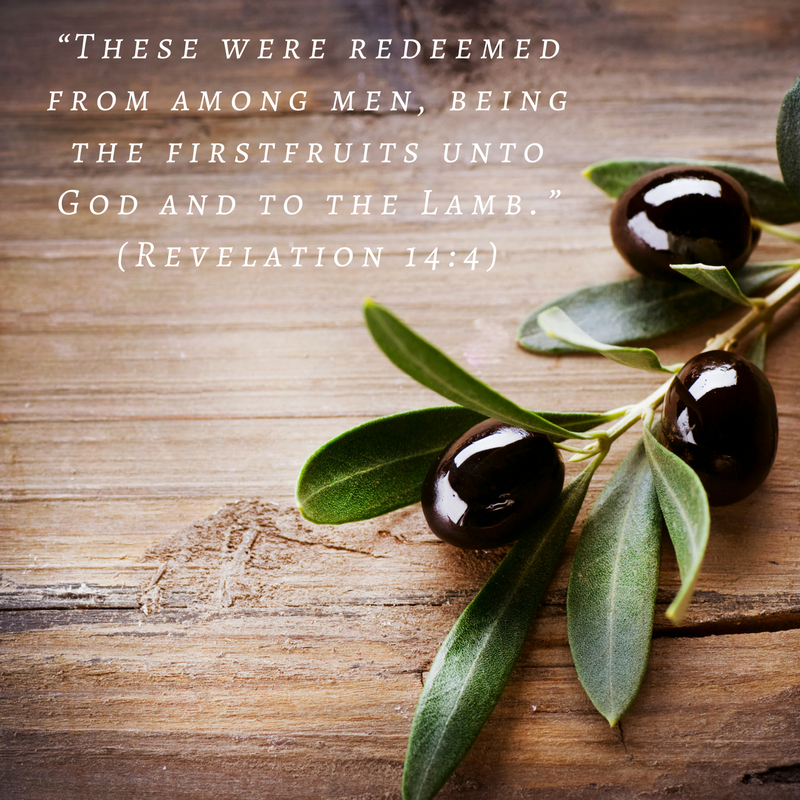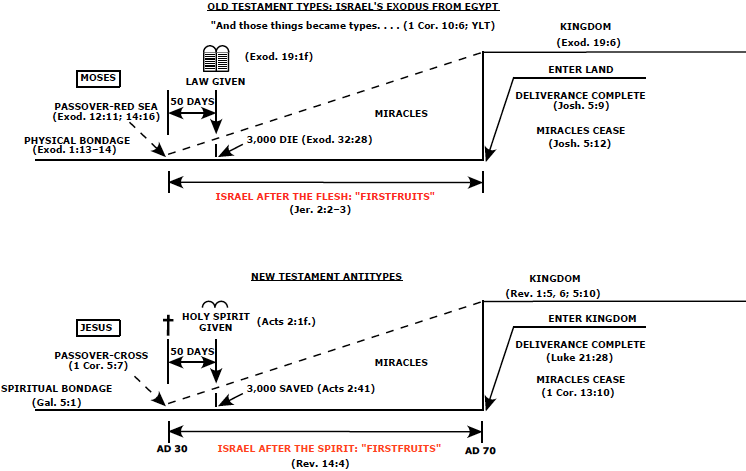
Our application of inmillennialism to this section of Revelation (Rev. 14:1–5) introduces the sixth mystic figure in this vision—the Lamb on Mount Zion (Rev. 14:1).
The Dragon (Satan) has attempted to destroy the Man-Child (Christ) at his birth (Rev. 12:4; cp. Matt. 2:16). When the Man-Child ascended to heaven (Rev. 12:5; cp. Mark 16:19), the Dragon attempted to destroy the Woman (Israel after the Spirit)1 in the land of Israel (Rev. 12:6–16; cp. Acts 1–12).
Failing in that attempt he sought help from the Sea Beast (the Roman Empire). Together they went to “make war with the remnant” of the Woman’s seed outside the land. The Sea Beast then persecutes Christians in other Roman provinces (Rev. 13:1–10; cp. Acts 13–28).
Another beast appeared in the land of Israel—a Land Beast (Rev. 13:11–16). This is the Sea Beast’s representative in the land (i.e., the Roman administration in Israel, the Herodian Dynasty, and the Sanhedrin). This Land Beast used demonic sorcery to deceive the inhabitants of the land (i.e., Israel after the flesh). He is doing the work of Rome and Nero Caesar, whose name in Hebrew is the number 666.2
Things are coming to a head. Those who have received the Sea Beast’s mark are near destruction, and it will come from the Beast to whom they swore allegiance. The vision is approaching the same climax as the other four judgment visions—the destruction of Jerusalem and its Temple in the Jewish wars of AD 66–70.3 The Lamb on Mount Zion vision provides comfort and assurance for the saints as they enter this “great tribulation” (Rev. 7:14; cp. Matt. 24:21).
This vision resembles Elisha and his fearful servant. The king of Syria had surrounded their “city both with horses and chariots. And his servant said unto him, Alas, my master! how shall we do? And he answered, Fear not: for they that be with us are more than they that be with them. And Elisha prayed, and said, LORD, I pray thee, open his eyes, that he may see. And the LORD opened the eyes of the young man; and he saw: and, behold, the mountain was full of horses and chariots of fire round about Elisha” (2 Kings 6:14–17).
Similarly, the Sea Beast’s (i.e., Rome’s) armies would soon surround and destroy Jerusalem (Luke 21:20). Jesus would be there in a cloud (Luke 21:27). He would ensure the safety of God’s saints just as the angels had delivered Elisha and his servant. John’s vision allows the saints to “see” their Protector in advance.
Exposition
John says, And I looked, and, lo, a Lamb stood on the mount Sion (Rev. 14:1). This is the Lord Jesus Christ, “the Lamb of God, which taketh away the sin of the world” (John 1:29). John sees the Lamb throughout Revelation.4 The Lamb will secure the defeat of the three-member evil alliance—the Dragon, Sea Beast, and Land Beast—and preserve the Israel of God.
John sees the Lamb “on Mount Zion.” This is a stark contrast to the Dragon standing “on the sand of the sea” (Rev. 12:17, ESV). The Dragon stands on a shifting and unstable footing while the Lamb is on an unmovable mountain, the heavenly mount of the Messianic Age to which the people of God had come (Heb. 12:22–24). It has replaced the earthly Mount Zion of the Mosaic Age (2 Sam. 5:7; Isa. 1:8; et al.) that God was about to destroy.
The context proposed by inmillennialism allows us to identify those standing with the Lamb, the hundred forty and four thousand, having his Father’s name written in their foreheads (Rev. 14:1). They are the remnant from the twelve tribes of Israel that believed the gospel of the kingdom and followed Christ during the “last days” of the Mosaic Age (Heb. 1:2; cp. Rev. 7:4–8). They comprise Israel after the Spirit or Messianic-Age Israel. Paul said, “Even so then at this present time also [i. e., during the “last days” of the Mosaic Age] there is a remnant according to the election of grace” (Rom. 11:5). John sees this remnant with Christ as the end of the age approaches.
These elect Christ-followers bore the Name on their foreheads. Figurative marks indicating servant ownership occur in six of Revelation’s seven visions: Rev 7:3 (second vision); Rev. 9:4 (third); Rev. 13:16; 14:1, 9 (fourth); Rev. 15:2; 16:2 (fifth); Rev. 20:4 (sixth); and Rev. 22:4 (seventh).
These marks are standard prophetic imagery. In a similar context—just before Jerusalem’s destruction in 587 BC—God spoke to Ezekiel: “Go through the midst of the city, through the midst of Jerusalem, and set a mark upon the foreheads of the men that sigh and that cry for all the abominations that be done in the midst thereof” (Ezek. 9:4).
Ezekiel was in Babylon, so God provided transportation to Jerusalem—a distance of about 900 miles. “The form of a hand” took Jeremiah by a lock of his head and the Spirit lifted him “up between the earth and the heaven” (Ezek. 8:3). God carried him to the Temple where he saw Israel’s abominations.
This was a visionary and non-literal transport. The marks Ezekiel saw on the foreheads of God’s faithful servants were also non-literal. This prophetic imagery shows how God distinguishes his faithful servants from apostates.
In Revelation, the marks show God will protect the Jews who bore the mark of the Lamb; they will “live and reign” with Christ in the Messianic Age (cp. Rev. 20:4). God will destroy their contemporaries—Israelites after the flesh only. John describes this destruction at the end of this vision (Rev. 14:6–19).
This remnant from Israel sings a new song. John says, And I heard a voice from heaven, as the voice of many waters, and as the voice of a great thunder: and I heard the voice of harpers harping with their harps (Rev. 14:2). Earlier, John heard the redeemed from all nations sing before the Lamb’s throne (Rev. 5:9–10).
John limits the singing and playing here to the redeemed remnant from Israel: And they sung as it were a new song before the throne, and before the four beasts, and the elders: and no man could learn that song but the hundred and forty and four thousand, which were redeemed from the [land5] (Rev. 14:3). John has already seen this Israel-remnant in the Seal Vision.6 There they “cried with a loud voice” praising Christ (Rev. 7:10). Here they learn a particular song that John will describe in the next vision.7
These singers are righteous. These are they which were not defiled with women; for they are virgins (Rev. 14:4). This does not mean they were celibate in every respect. This standard prophetic imagery shows spiritual purity. Jeremiah’s description of Israel as “the virgin daughter” (Jer. 14:17) does not imply an absence of childbearing in Mosaic-Age Israel. This metaphor describes Israel’s special relation to God.
Jesus named two groups of “virgins” in Israel in his generation (cp. Matt. 25:1–13).8 One group was unprepared to enter the Messianic Age. The other group—those prepared and ready—is the one John sees in this vision. These are they which follow the Lamb whithersoever he goeth (Rev. 14:4).
John uses another metaphor of special interest to inmillennialism. These were redeemed from among men, being the firstfruits unto God and to the Lamb (Rev. 14:4; emphasis added). This “firstfruits” image comes from a long scriptural tradition (e.g., Exod. 23:16, 19; 34:22, 26; et al.). The word (Gk. aparchē) means “the first of the ripe fruits.”9 Paul applies it to Christ’s resurrection: he is the “firstfruits of them that slept” (1 Cor. 15:20, 23; emphasis added).
If this vision pertains to the end of the Messianic Age, we have a problem. How could John describe coverts then as “the firstfruits unto God and to the Lamb”? They would be the “lastfruits,” if such a word existed.
“Firstfruits” fits well in inmillennialism. John is describing the elect remnant in Israel during the “last days” (Heb. 1:2) of the Mosaic Age. These were also the first days of the Messianic Age. The redeemed remnant from Israel was the firstfruits of the kingdom of God.
Inmillennialism’s typology also matches “firstfruits” here.10 When John sees the Lamb on Mount Zion, the Woman is still in the wilderness fighting the Dragon, Sea Beast, and Land Beast. Is it just another “curious coincidence”11 that God applied the term “firstfruits” to Israel while she was in the wilderness after leaving Egypt? Speaking of that time, God said, “I remember thee, the kindness of thy youth, the love of thine espousals, when thou wentest after me in the wilderness, in a land that was not sown. Israel was holiness unto the LORD, and the firstfruits of his increase” (Jer. 2:2–3; emphasis added).
Both Israel after the flesh in the wilderness after leaving Egypt and Israel after the Spirit in the wilderness after their “Exodus” in Christ (Luke 9:31, Gk. exodos; cp. Rev. 12:6) were firstfruits to God. The typology, the vision, and the historical events agree with one another.

These Revelation firstfruits were blameless. And in their mouth was found no guile: for they are without fault before the throne of God (Rev. 14:5). Paul put it this way: “Israel12 hath not obtained that which he seeketh for; but the election13 hath obtained it, and the rest were blinded” (Rom. 11:7). God had imputed the righteousness of Christ to the elect in Israel (cf. 2 Cor. 5:21; Rom. 4:11–25). The rest remained in their sins.
Conclusion
The saints to whom John wrote were entering the “great tribulation” (Rev. 7:14; Matt. 24:14). The Lamb on Mount Zion vision provided support and encouragement for them. God would remain faithful to his ancient promises and preserve Israel after the Spirit. The Lamb would lead them into the Messianic Age.
Before doing so, he would destroy Israel after the flesh and the institutions of the Mosaic Age. This will be the subject of our next post (D. V.).
Footnotes
- For a definition of Israel in these visions, see our posts The Seven Mystic Figures — Part 1: Identities and The Seven Mystic Figures — Part 2: Exodus.
- See our post, The Seven Mystic Figures — Part 5: Land Beast.
- See our post, Repetition In Revelation.
- See Rev. 5:6, 8, 12, 13; 6:1, 16; 7:9, 10, 14, 17; 12:11; 13:8; 14:1, 4, 10; 15:3; 17:14; 19:7, 9; 21:9, 14, 22, 23, 27; 22:1, 3.
- Gk. gē. See our Glossary entry here.
- See Rev. 7:1–12.
- For those who can’t wait, it is the song God gave Moses to be sung during Israel’s “latter days” (Deut. 31:22–32:43).
- See our post Parables Of Watchfulness.
- Spiros Zodhiates, The Complete Word Study Dictionary: New Testament (Chattanooga, TN: AMG Publishers, 2000), s.v. 536. ἀπαρχή aparchḗ.
- See Typology And Inmillennialism.
- Philip Carrington, The Meaning of the Revelation, (Eugene, OR: Wipf & Stock Pub, 2008), 187. We have seen several facts that match inmillennialism in “curious” ways but do not fit well in other prophetic frameworks. Our repeated use of his term does not mean Carrington would approve our analysis.
- That is, the non-elect in Israel after the flesh.
- That is, the elect in Israel after the flesh. Again, we request the reader consult the definitions of “Israel” in our posts The Seven Mystic Figures — Part 1: Identities and The Seven Mystic Figures — Part 2: Exodus.
